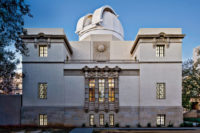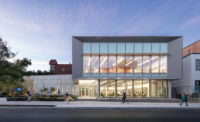The Gwinnett Environmental & Heritage Center (GEHC) is a hands-on science learning center dedicated to increasing appreciation and understanding of water resources in Gwinnett County, a suburb of Atlanta. The center challenges children as well as adults to explore the impact that water has had on their everyday lives as well as future water management challenges. It is the county’s first green building–and it features what might well be the largest sloped green roof in the United States. Embodying the principles of conservation, the GEHC is projected to use 75 percent less potable water and 35 percent less energy than a conventional building of the same size.
The owner, architect, and landscape architect combed 233 acres set aside for the project and chose a building site that minimized the need for grading and would retain most of the existing tree canopy for shading. Most important, the designers chose a site that features a dry ravine. Taking its form in part from the site, the GEHC consists of two wings joined by a bridge spanning the ravine, which the designers used for a cascading water feature. Water from this feature recirculates throughout the building and is used for air conditioning, irrigation, and flushing toilets. It draws clean but non-potable water from the county’s nearby sewage treatment facility.
The 40,000-square-foot vegetated roof floats above a continuous band of windows. More than half of its surface is pitched at a 4:12 ratio. The roof helps clean and reduces the quantity of storm water runoff. It also mitigates the heat island effect and provides a natural habitat for insects and other wildlife. Planted with six species of drought-resistant flowering sedum, the vegetation needs no irrigation. The GEHC’s other key sustainable features include: deep roof overhangs on the north and south for shading; natural lighting provided by strategically located clerestory windows; automatic relief louvers that integrate fresh air circulation when temperatures are favorable; and granite cladding salvaged from another building nearby. The GEHC achieves its owner’s vision that it be a working model of ecologically sustainable design.
PeopleOwner Gwinnett County, Georgia Architect Lord, Aeck & Sargent Principal in charge: John Star Project architect / manager: Meg Needle, Hank Houser Architectural staff: Eighrene Gabrielle, Will Hall, Tom Butler, Jim Nicolow Interior designer Claire Oviatt with Lord Aeck Sargent Engineer(s) Structural: Uzun & Case M/e/p, fire protection: Newcomb & Boyd Civil: Lose & Associates Consultant(s) Landscape: The Jaeger Company Lighting: Newcomb & Boyd Exhibits: Van Sickle & Rolleri A/v: Waveguide General contractor Juneau Construction with ECI (exhibits) and TSAV (classrooms, lecture and conference rooms) Photographer(s) Jonathan Hillyer Photography Renderer: Barbara Ratner AD system, project management, or other software used: Microstation V8 |
ProductsStructural system DeKalb Steel Exterior Cladding Masonry: Elberton Granite Metal/glass curtainwall: YKK Concrete: LaFarge Wood: Southern Yellow Pine Roofing Elastomeric: American Hydrotech Rubberized Asphalt Other: Growing Media by ERTH Products (American Hydrotech Litetop) Glazing Glass: Viracon Doors Entrances: YKK Metal doors: D & D Wood doors: Eggers Overhead rolling door: Cookson Hardware Locksets: Best Closers: Dorma Interior finishes Acoustical ceilings: Armstrong Cabinetwork and custom woodwork: Lab casework by Kewaunee Paints and stains: Sherwin Williams Wallcoverings: Amcork Special surfacing: Terroxy epoxy terrazzo in gallery floors by Adams Tile & Terrazzo Floor and wall tile: Ceramic tile in H20 interactive area and restrooms by Crossville Carpet: C&A Floor Coverings Furnishings Office furniture: Haworth Chairs: Chromcraft Lighting Interior ambient lighting: Lightolier Downlights: Lightolier Exterior: LSI Architectural Outdoor Lighting Controls: ETC Conveyance Elevators/escalators: Thyssen Krup Elevator Plumbing Kohler, Zurn and Sloan
|









